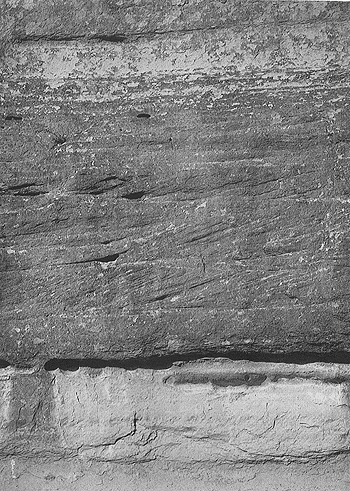
Stratification: hierarchy and cyclicity (2)
Plate 22

Stratification: hierarchy and cyclicity (2)
Plate 22
We observe again, at a closer distance, a sandstone body comprised between poorly bedded siltstones: meso-scale structures are visible in this case. First of all, a vertical asymmetry can be noted: the base is sharpcut, the top transitional; component beds are thicker and coarser grained in the lower part, thinner and finer grained in the upper one. This package clearly shows a thinning and fining up trend. By the way, note here that vertical changes in grain size can occur at two distinct hierarchical levels: within individual beds or layers or within bedsets and multilayer bodies. To avoid confusion in descriptions, use different terms for the two cases: grading (or graded bedding) and fining up, respectively.
Further observations can be added to foster the interpretation of this sandstone body. The base seems to truncate underlying deposits and can be regarded as erosional. Above it, a structureless bed occurs, which could be interpreted either as a mass flow deposit or as a tractive deposit destructured by organisms or some other process. Then a set of roughly parallel beds follows, separated by wavy surfaces and internally subdivided into inclined (20°-25°) laminae dipping to the left. The lamination, of the foreset type (see plates 25-35), is the product of a tractive current that flowed from right to left and made subaqueous dunes on the bottom sediment. Finally, the topmost thin beds have the shape of flat wedges and contain laminae, which dip at much lower angles or are subhorizontal. As we shall see (plates 40, 41, 47, 48, 49), low-angle lamination is often produced by wave action.
Lower Miocene fossiliferous sandstones and siltstones of the Epiligurian Sequence, near San Leo, Marecchia Valley, northern Apennines.
This picture documents the temporal succession of different processes and events. The fossil remains (skeletal material within the sandstone) and the tractive structures testify to a marine, shallow-water setting. This is a broad interpretation, a first approximation. The sedimentary structures tell us more; why, for example, do we pass from current-dominated structures to wave-dominated structures? And what type of current made the cross-bedding? Moreover, we should try to understand the kind of basal erosion: was it produced by a single, instantaneous event, such as a big storm, or by many events distributed over a long time interval? In other words, was the erosion a catastrophic or a "normal," slow and gradual process?
We can imagine a shallow bay or a lagoon delimited seaward by barrier islands. The islands are made of sand and dissipate the incoming wave energy; they thus protect the embayment, where fine sediment can accumulate. Mechanical energy can, however, penetrate into the protected environment through channels between the islands (tidal inlets): these channels are cut and kept open by tidal currents to maintain water exchange with the open sea. The channels are not stationary if the waves impinge obliquely on the sand islands: some sand is deposited on one side, whereby the tidal current is obliged to erode the other side. In this way, the channel migrates as a fluvial meander does; its depth remaining constant, the results of this migration are the lateral prosecution of basal erosion and the progressive abandonment of the channel by lateral accretion.
With time, the channel bottom becomes a planar erosional surface; this surface is obviously diachronous. Sand is transported and locally accumulated in the lower section of the channel by tidal flows; dunes are formed in it and migrate in the current direction. The tidal motion is weaker in the upper channel section and outside the channel; there, waves leave their imprint on the sand. They form spits and sand ridges, and sedimentary structures of various scales. Such features will be recorded in the topmost portion of the stratigraphic sequence.
In essence, this interpretation explains the sandstone body as the
fill of a migrating channel by the combined action of tidal currents
(main responsible for the channel existence) and waves in a littoral
setting. The growth model would be a composition of vertical and lateral
accretion. Physical evidence of lateral accretion (clinoforms) is,
however, scarce, and other explanations are possible.